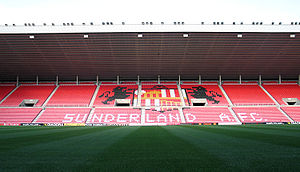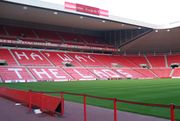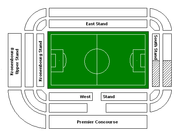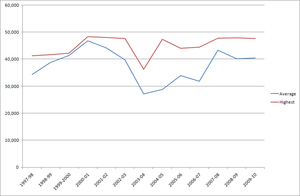Stadium of Light
| Stadium of Light | |
|---|---|
 |
|
| Full name | Stadium of Light |
| Location | Stadium Of Light Sunderland SR5 1SU |
| Opened | 1997 |
| Owner | Sunderland A.F.C. |
| Surface | Grass |
| Construction cost | £23million |
| Architect | TTH Architects |
| Main contractors | Ballast Wiltshire PLC |
| Capacity | 49,000 |
| Field dimensions | 115 × 75 yards (105 × 68 metres) |
| Tenants | |
| Sunderland A.F.C. (1997–present) | |
The Stadium of Light is an all-seater football stadium in Sunderland, England. With space for 49,000 spectators, the Stadium of Light has the fifth-largest capacity of any English football stadium. The stadium primarily hosts Sunderland A.F.C. matches.
As well as hosting Sunderland games, the stadium has hosted two matches for the England national football team, as well as one England under-20 football team match. With an original capacity of 42,000, it was expanded in 2002 to seat 49,000, and its simple design is expected to allow for redevelopments up to an eventual capacity of 64,000. The attendance record at the Stadium of Light is 48,353 set on 13 April 2002, when Sunderland played Liverpool. Along with hosting football matches, the stadium hosted two concerts in 2009, with Oasis and Take That as main performers. The ground also holds conference and banqueting suites, the Black Cats Bar, and a club shop selling Sunderland merchandise.
On 16 December 2009 the stadium was selected as a venue to be included in the The Football Association's bid to host the 2018 FIFA World Cup.[1]
Contents |
History
Following the release of the Taylor Report in January 1990, Sunderland were obliged to make plans to turn their Roker Park home into an all-seater stadium, as they were then in the Second Division and all clubs in the First and Second Divisions would be required to have all-seater stadiums by August 1994 and the Third and Fourth Divisions by August 1999.[2] Roker Park was a ground that mainly consisted of standing terraces, and if converted into all-seater it would have held far fewer spectators than before.[2] Enclosed by residential streets on all sides, expansion was practically impossible. So, in the early 1990s, Sunderland began investigating the possibility of relocation.[2]
The front-runner that emerged was a proposed stadium located on an area of land adjacent to the Nissan car plant.[3] The 48,000 seater gound was labelled "the Wembley of the North".[3] The plans did not come to fruition. In 1992, Nissan launched an official objection, ultimately forcing Sunderland to abandon the idea.[3] In 1995, Sunderland put forward a plan to build a 34,000-seat bowl-shaped stadium on the former site of Wearmouth Colliery.[3] The area, on the north bank of the River Wear in the Sheepfolds district of Sunderland, was only a few hundred yards from Roker Park, and close to the centre of the city. On 13 November 1995, the Sunderland Chairman Bob Murray announced that the Tyne and Wear Development Corporation had approved plans for Sunderland to build the new stadium on the site.[4]

Ballast Wiltshier plc, a contracting company that had built the Amsterdam Arena, was contracted to build the stadium at an initial cost of £15 million.[4] In June 1996, as the planned capacity rose to 42,000, construction work began.[4] The capacity was revised again in early 1997, and the stadium was completed on time, with a capacity of 42,000.[4] In 2003 the club announced plans to increase the groud capacity to 49,000, however relegation that year put such plans on hold.
Should the club attain consistent top half finishes the stadium was designed for expansion by addition of an upper tier, up to a maximum capacity of 64,000 – which in relation to the current capacities of other English clubs would only be surprassed by Manchester United's Old Trafford.[5]
During construction, the stadium had not adopted an official name, and had been known colloquially as the "Wearside Stadium" and "New Roker Park".[6] The name was eventually revealed as the Stadium of Light, a reference to a miner's lamp (the stadium is built on the site of the old Wearmouth Colliery, and many Sunderland fans have worked in the region's mines).[6] This was an unpopular choice at the time, as there was already a famous "Stadium of Light" in Portugal, which was the home of Benfica. To emphasise the local origins of the name choice, a Davy lamp is in front of the stadium's ticket office, adjacent to the stadium.[6] The stadium was opened on 30 July 1997 by Prince Andrew, Duke of York, with bands such as Status Quo, Upside Down and Kavana playing. To celebrate the opening of the stadium, Sunderland played a friendly against Ajax, which was drawn 0–0.[4] The first competitive game was against Manchester City which Sunderland won 3–1. The attendance was 34,776.
The North Stand was extended in 2000 to bring the capacity to 49,000, costing the club a further £7 million, making the final cost of the stadium £23 million.[5] On 18 July 2006, a statue of 1973 FA Cup Final winning manager Bob Stokoe (who died two years earlier) was unveiled.[7] At the end of season Football League awards, the Stadium of Light was named the Best Away Ground, with other contenders including Crewe Alexandra's Alexandra Stadium and Plymouth Argyle's Home Park.[8] Sunderland celebrated the ten year anniversary of the stadium with a pre-season friendly against Juventus on 6 August 2007, the game was drawn 1–1.[9]
Structure and facilities

The stadium is in the shape of a square bowl, and is separated into the West Stand, North Stand, East Stand (formerly the Vaux Stand, the Carling Stand, and Fosters Stand respectively), and the South Stand (also known as the Metro FM Stand).[10] The West Stand includes the Premier Concourse which is the name of the upper tier, and a number of executive boxes.[11] The North Stand also includes an upper tier, called the Kronenbourg Upper Stand, which contains the Black Cats Bar.[12]
The pitch is several metres below the level of the ground outside of the stadium.[13] The pitch uses a lighting system from Stadium Grow Lighting to ensure the grass can grow at any time of year. The device controls the factors of the pitch, including exposure to light, temperature, water, and air, to make the grass able to grow in any condition.[14] Away fans are seated in the west half of the South Stand.[10] The East Stand has the Sunderland emblem on the seats, while the North Stand has the slogan "Ha'way The Lads". The stadium also has a Davy lamp monument, and a statue of Bob Stokoe. The perimeter walls of the stadium incorporates a "Wall of Fame" feature, where names can be engraved into the bricks of the walls.[15] The interior of the stadium holds a banqueting suite, which can seat from 460 to 600 people.[16] The stadium also contains several conferencing suites, that can be hired for events.[17]
Other uses
As well as holding Sunderland games, the stadium has also hosted England matches. It hosted its first England game, when they played Belgium on 10 October 1999 in a friendly match, which England won 2–1.[18] It played host to its first competitive England match on 2 April 2003, when they played Turkey in a UEFA 2004 qualifying match, which England won 2–0.[19] The Stadium of Light also held an England under 20 match against Italy on 27 November 2002, Italy beat England 5–3.[20]
The Stadium of Light currently hosts the annual graduation ceremony for the students of the University of Sunderland.[21] The stadium won the RSVP magazine's Most creative use of a sporting venue award in 2007 for its usage as the universities graduation site.[22] On 16 October 2008 it was announced that the stadium would hold a concert on 10 June 2009, featuring Oasis, with Kasabian, The Enemy and Reverend and the Makers as support acts, with the stadium housing roughly 60,000 fans (both seated and standing).[23] Shortly after on 28 October 2008, English pop group Take That confirmed they would start their nationwide 'Circus' tour at the Stadium of Light,[24] with The Saturdays, James Morrison and Gary Go performing as support acts.
Records

The highest recorded league attendance at the Stadium of Light is 48,353 set on 13 April 2002 for the Sunderland vs Liverpool game. The lowest league attendance at the stadium was 22,167 against Wigan Athletic on 2 December 2003.[25]
The highest seasonal average at the stadium since it was opened was 46,790 in the 2000–01 season while Sunderland were playing in the Premier League.[26] The lowest average attendance at the Stadium of Light was 27,119 in the 2003–04 season in Division One.[27] The highest total seasonal attendance was recorded during the 1998–99 season when the aggregate was 890,660 in a season where Sunderland were First Division champions, and League Cup semi-finalists.[28] The lowest seasonal aggregate at the Stadium of Light was 623,741 in the 2003–04 season, the same season that the club were FA Cup and play off semi-finalists.[27]
Transport
Sunderland station, which is now connected to London Kings Cross by services run by the Open Access operator Grand Central Railway, is located nearby to the stadium.[29] The St Peter's and Stadium of Light Metro stations were built to serve the stadium. The Metro was extended into Sunderland in 2002.[30] A park and ride system is available on match days to allow spectators to park away from the stadium,[31] and a new footbridge proposal has been put forward to link the stadium to the south bank of the river as part of the stadium park regeneration project.[32]
Footnotes and references
Footnotes:
- ↑ "World Cup Bid Cities announced". BBC News. 16 December 2009. http://news.bbc.co.uk/sport1/hi/football/internationals/8414235.stm. Retrieved 16 December 2009.
- ↑ 2.0 2.1 2.2 Days, pp297-298.
- ↑ 3.0 3.1 3.2 3.3 Days, pp299-300
- ↑ 4.0 4.1 4.2 4.3 4.4 Days, p301
- ↑ 5.0 5.1 Days, p303
- ↑ 6.0 6.1 6.2 Days, p302
- ↑ Alexander, Nick (18 July 2006). "Stokoe statue unveiled". Sunderland A.F.C.. http://www.safc.com/news/?page_id=9960. Retrieved 6 December 2008.
- ↑ Alexandra, Nick (5 March 2007). "SoL voted best away ground". Sunderland A.F.C.. http://www.safc.com/articles/article.php?page_id=11883. Retrieved 6 December 2008.
- ↑ Taylor, Louise (6 August 2007). "Keane eyes Mido and Gordon as Ranieri backs Black Cats to surprise". http://www.guardian.co.uk/football/2007/aug/06/newsstory.sunderland. Retrieved 6 December 2007.
- ↑ 10.0 10.1 "2008/09 Matchday Prices". Sunderland A.F.C.. http://www.safc.com/tickets/?page_id=12682. Retrieved 6 December 2008.
- ↑ "Executive Boxes". Sunderland A.F.C.. http://www.safc.com/hospitality/?page_id=9664. Retrieved 6 December 2008.
- ↑ "Black Cats Bar". Sunderland A.F.C.. http://www.safc.com/hospitality/?page_id=9666. Retrieved 6 December 2008.
- ↑ "SoL 10th anniversary". Sunderland A.F.C.. http://www.safc.com/anniversary/?page_id=12626. Retrieved 6 December 2008.
- ↑ "The Pitch". Sunderland A.F.C.. http://www.safc.com/club/?page_id=2809&page=1. Retrieved 6 December 2008.
- ↑ "SAFC Wall of Fame". Sunderland A.F.C.. https://www.safc.com/shop/?page_id=2634. Retrieved 6 December 2008.
- ↑ "Banqueting Suite". Sunderland A.F.C.. http://www.safc.com/home/?page_id=9814. Retrieved 6 December 2008.
- ↑ "Suite Specifications". Sunderland A.F.C.. http://www.safc.com/uploads/documents/jan_08/safc_1200485425_Suite-Specifications.jpg. Retrieved 6 December 2008.
- ↑ "England 2 Belgium 1". England Football Online. http://www.englandfootballonline.com/Seas1990-00/1999-00/M0762Bel1999.html. Retrieved 6 December 2008.
- ↑ "England surge past Turkey". BBC Sport. 2 April 2003. http://news.bbc.co.uk/sport2/hi/football/internationals/england/2909009.stm. Retrieved 6 December 2008.
- ↑ Wright, James (27 November 2002). "Under-20s given the Chop by Italy". The FA. http://www.thefa.com/England/U20s/NewsAndFeatures/Postings/2002/11/32265.htm. Retrieved 6 December 2008.
- ↑ "Venue & Merchandise". University of Sunderland. http://www.sunderland.ac.uk/university/graduation/venue-mechandise/. Retrieved 6 December 2008.
- ↑ "SoL wins national award". Sunderland A.F.C.. http://www.safc.com/home/?page_id=13236. Retrieved 12 December 2008.
- ↑ "Oasis to play Stadium of Light". Sunderland Echo. 16 October 2008. http://www.sunderlandecho.com/news/Oasis-to-play-Stadium-of.4600118.jp. Retrieved 6 December 2008.
- ↑ Carruthers, Marissa (28 October 2008). "Take That to play Stadium of Light". Sunderland Echo. http://www.sunderlandecho.com/news/Take-That-to-play-Stadium.4634641.jp. Retrieved 6 December 2008.
- ↑ "Sunderland 1–1 Wigan Athletic". The Stat Cat. http://thestatcat.co.uk/Imatchdets/IMD1191.asp. Retrieved 6 December 2008.
- ↑ "2000–01 season". The Stat Cat. http://thestatcat.co.uk/Mseasons/MSG122.asp. Retrieved 6 December 2008.
- ↑ 27.0 27.1 "2003–04 season". The Stat Cat. http://thestatcat.co.uk/Mseasons/MSG125.asp. Retrieved 6 December 2008.
- ↑ "1998–99 season". The Stat Cat. http://thestatcat.co.uk/Mseasons/MSG120.asp. Retrieved 6 December 2008.
- ↑ "Our Route & Services". Grand Central Railway. http://www.grandcentralrail.co.uk/our_service.html. Retrieved 6 December 2008.
- ↑ "Tyne & Wear Metro Rapid-Transit System, United Kingdom". Railway Technology. http://www.railway-technology.com/projects/tyne/. Retrieved 6 December 2008.
- ↑ "Park and Ride". Sunderland A.F.C.. http://www.safc.com/tickets/?page_id=6428. Retrieved 6 December 2008.
- ↑ "Area Proposals — Sunderland North". Sunderland City Council. http://www.cartoplus.co.uk/sunderland/text_alt_2/04_northsund.htm. Retrieved 6 December 2008.
References:
- Days, Paul; John Hudson, John Hudson, Bernard Callaghan, (1 December 1999). Sunderland AFC: The Official History 1879–2000. Business Education Publishers Ltd. p. 336. ISBN 978-0-9536984-1-7. http://www.amazon.co.uk/Sunderland-AFC-Official-History-1879-2000/dp/0953698416.
External links
- BBC Wear Interactive 360 degree views of the Stadium of Light
|
|||||||||||
|
|||||||||||
|
|||||||||||||||||||||||||||||||||